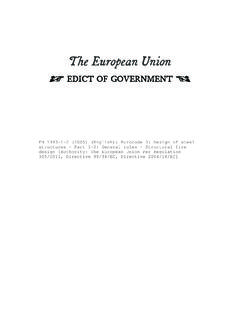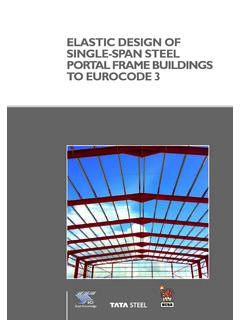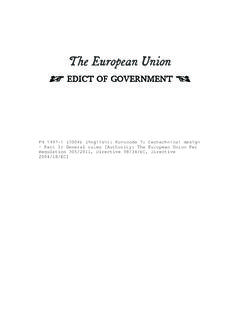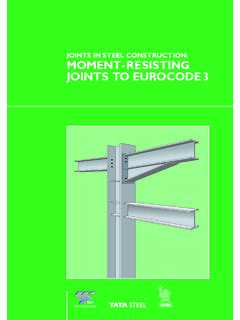Transcription of EN 1993-1-2: Eurocode 3: Design of steel structures - Part ...
1 The European UnionIn order to promote public education and public safety, equal justice for all, a better informed citizenry, the rule of law, world trade and world peace, this legal document is hereby made available on a noncommercial basis, as it is the right of all humans to know and speak the laws that govern them. EDICT OF GOVERNMENT EN 1993-1-2 (2005) (English): Eurocode 3: Design of steelstructures - Part 1-2: General rules - Structural firedesign [Authority: The European Union Per Regulation305/2011, Directive 98/34/EC, Directive 2004/18/EC]EUROPEAN STANDARD EN 1993-1-2 NORME EUROPEENNE EUROpAISCHE NORM ICS ; ; April 2005 English version Supersedes ENV 1993-1-2: 1995 Incorporating Corrigendum December 2005 Eurocode 3: Design of steel structures - Part 1-2: General rules -Structural fire Design Eurocode 3: Calcul des structures en acier - Partie 1-2: Regles generales - Calcul du comportement au feu Eurocode 3: Bemessung und Konstruktion von Stahlbauten - Teil 1-2: Allgemeine Regeln - Tragwerksbemessung fOr den Brandfall This European Standard was approved by CEN on 23 April 2004.
2 CEN members are bound to comply with the CEN/CENELEC Internal Regulations which stipulate the conditions for giving this European Standard the status of a national standard without any alteration. Up-to-date lists and bibliographical references concerning such national standards may be obtained on application to the Central Secretariat or to any CEN member. This European Standard exists in three official versions (English. French. German). A version in any other language made by translation under the responsibility of a CEN member into its own language and notified to the Central Secretariat has the same status as the official versions. CEN members are the national standards bodies of Austria, Belgium, Cyprus, Czech Republic, Denmark, Estonia, Finland, France, Germany, Greece, Hungary, Iceland, Ireland, Italy, Latvia, Lithuania, Luxembourg, Malta, Netherlands, Norway, Poland, Portugal, Slovakia, Slovenia, Spain, Sweden, Switzerland and United Kingdom.
3 EUROPEAN COI'vlMITTEE FOR STANDARDIZATION COMITE EUROP DE NORl\lALISATION KOMITEE FOR NORI'vlUNG Management Centre: rue de Stassart, 36 B-1050 Brussels 2005 CEN All rights of exploitation in any form and by any means reserved worldwide for CEN national Members. Ref. No. EN 1993-1-2: 2005: E BS EN 1993-1-2: 2005 EN 1993-1-2: 2005 (E) Contents Page Fore\vord .. 4 1. General .. 9 1.] Scope .. 9 Norn1ative rcferences .. 10 Assun1ptions .. 11 Distinction between principlcs and application mles .. l1 TernlS and definitions .. 11 Synlbols .. 12 2 Basis of desigll .. 16 2. 1 Requ irenlcnts .. 16 Basic requirelllents .. 16 2.] .2 Nominal fire exposure .. 16 2. J .3 Paranletric fire exposure .. 16 Actions .. 17 Design values of material propcrties .. 17 Verification 111cthods .. 17 General .. 17 Melnber analysis .. 18 Analysis of part of the stmcture .. 19 Global structural analysis.
4 20 3 Material properties .. 20 General .. 20 Mechanical properties of carbon steels .. 20 ] Strength and deformation propcrties .. 20 Unit 111ass .. 20 Mechanical properties of stainless stcels .. 23 Thernlal properties .. 23 Carbon steels .. 23 Stainless steels .. 26 Fire protection lnaterials .. 26 4 Structural fire Design .. 27 General .. 27 Simple calculation models .. 27 L General .. 27 Classification of cross-sections .. 28 Resistance .. 28 Critical tel11perature .. 36 steel temperature development .. 37 Advanced calculation models ..43 ] General .. 43 Thernlal response .. 43 l\1echanical response .. 43 Validation of advanced calculation models .. 44 Annex A Inormative] Strain-hardening of carbon steel at elevated temperatures .. 45 Annex B [nonnative] Heat transfer to external steelwork ..47 Annex C [inforlnativel Stainless steel .
5 65 Annex D linfornlative] Joints .. 73 2 85 EN 1993 .. 1 2:2005 EN 1993-1-2: 2005 (E) Annex E [informative] Class 4 cross-sections .. 76 3 BS EN 1993-1-2: 2005 EN 1993 .. 1-2:2005 (E) Foreword This Europcan Standard EN 1993, EUfocode 3: Design of steel structurcs, has been prepared by Technical Committee CEN/TC250 Structural Eurocodes , the Secretariat of which is held by BSI. CEN/TC250 is responsible for all Structural Eurocodcs. This European Standard shall be given the status of a National Standard, either by publication of an identical text or by endorsement, at the latest by October 2005, and cont1icting National Standards shall bc withdrawn at latest by March 20 10. This Eurocode supersedcs ENV 1993-1-2. According to thc CEN-CENELEC Intcrnal Regulations, the National Standard Organizations of thc following countries are bound to implement these European Standard: Austria, Belgium, Cyprus, Czech Republic, Dcnmark, Estonia, Finland, France, Germany, Greece, Hungary, Iceland, Ircland, Italy, Latvia, Lithuania, Luxembourg, Malta, Nethcrlands, Norway, Poland, Portugal, Slovakia, Slovenia, Spain, Swedcn, Switzerland and United Kingdom.
6 Background to the Eurocode programme In 1975, the Commission of thc European Community decided on an action programme in the field of construction, based on article 95 of the Treaty. The objective of the programme was the elimination of technical obstacles to trade and the harmonization of tcchnical specifications. Within this action programme, thc Commission took the initiative to establish a set of harmonized technical rules for the Design of construction works which, in a first stage, would servc as an alternative to the national rules in force in thc l\1ember States and, ultimately, would replace them. For fifteen years, the Commission, with the help of a Steering Committee with Representatives of Membcr States, conducted the developmcnt of the Eurocodes programme, which led to thc first generation of Europcan codes in thc 1980s. In 1989, the Commission and the l\1ember Statcs of the EU and EFTA decided, on the basis of an agreement!
7 Bctwecn the Commission and to transfer the preparation and the publication of the Eurocodes to CEN through a series of Mandates, in order to provide them with a future status of European Standard (EN). This links de facto thc Eurocodes with the provisions of all the Council's Directives and/or Commission's Decisions dealing with European standards ( the Council Directive 89/1 06/EEC on constl1 Jction products -CPD - and Council Directives 93/37/EEC, 92/50/EEC and 89/440/EEC on public works and services and equivalent EFTA Directives initiated in pursuit of setting up the internal market). The Stmcturai Eurocode programme comprises the following standards generally consisting of a number of Parts: EN 1990 EN 1991 EN 1992 EN 1993 EN 1994 EN 1995 EN 1996 EN 1997 EN 1998 EN 1999 Eurocodc 0: Eurocode 1: Eurocodc 2: Eurocode 3: Eurocode 4: Eurocode 5: Eurocode 6: Eurocode 7: Eurocode 8: Eurocode 9: Basis of Structural Design Actions on structurcs Design of concrcte stmctures Design of stecl stmctures Design of composite steel and concrete structures Design of timber stmctures Design of masonry stmctures Geotechnical Design Design of stmctures for earthquake resistance Design of aluminium structurcs 1 Agreement between the Commission of the European Communities and the European Committee for Standardisation (CEN) concerning the work on EUROCODES for the Design of building and civil engineering works (BC/CEN/03/89).
8 4 BS EN 1993-1-2: 2005 EN 1993-1-2: 2005 (E) Eurocode standards recognize the responsibility of regulatory authorities in each Member State and have safeguarded their right to determine values related to regulatOlY matters at national level where these continue to ValY from State to State. Status and field of application of eurocodes The Member States of the EU and EFTA ' Ot"An, '(,' that Eurocodes serve as reference documents for the following purposes: as a means to prove compliance of building and civil engineering works with the essential requirements of Council Directive particularly Essential Requirement N I I'v1ccbanical resistance and stability and Essential Requirement N 2 - Safety in case of fire; as a basis for specifying contracts for construction works and related engineering as a framework for drawing up harmonized technical specifications for construction products (ENs and ETAs) The Eurocodes, as far as they concern the construction works themselves, have a direct relationship with the Interpretative Documents2 referred to in Article 12 of the CPD, although they are of a different nature from harmonized product standards3 Therefore, technical aspects arising from the Eurocodcs work need to bc adequately considered by CEN Technical Committees and/or EOTA Working Groups working on product standards with a view to achieving full compatibility of these technical specifications with the Eurocodes.)
9 The Eurocode standards provide common structural Design rules for everyday use for the Design of whole structures and component products of both a traditional and an innovative nature. Unusual forms of construction or Design conditions are not specifically covered and additional expert consideration will be required by the designer in such cases. National Standards implementing Eurocodes The National Standards implementing Eurocodes will comprise the full text of the Eurocode (including any annexes), as published by CEN, which may be preceded by a National title page and National foreword, and may be followed by a National annex. The National annex may only contain information on those parameters which are left open in the Eurocode for national choice, known as Nationally Determined Parameters, to be used for the Design of buildings and civil works to be constructed in the country concerned, : values and/or classes where alternatives arc given in the Eurocode , values to be used where a symbol only is given in the Eurocode , country data (geographical, climatic, etc.)
10 , snow map, the procedure to be used where alternative procedures are given in the Eurocode . It may contain decisions on the application of informative annexes, references to non-contradictory complementary information to assist the user to apply the Eurocodc. 2 According to Art. of the CPD, the essential requirements (ERs) shall be given concrete form in interpretative documents for the creation of the necessary links between the essential requirements and the mandates for harmonized ENs and ET AGs/ET As. According to Art. 12 of the CPO the interpretative documents shall: a) give concrete form to the essential requirements by harmonizing the terminology and the technical bases and indicating classes or levels for each requirement where b) indicate methods these classes or levels of requirement with the technical methods or ccllcubtion and of proof, technical rules for etc, ; c) serve as a rcfercnce eSI[lbJI:;1111"lcnt of harmonized standards nnd guidelines lor European technical 8pprovals.]










